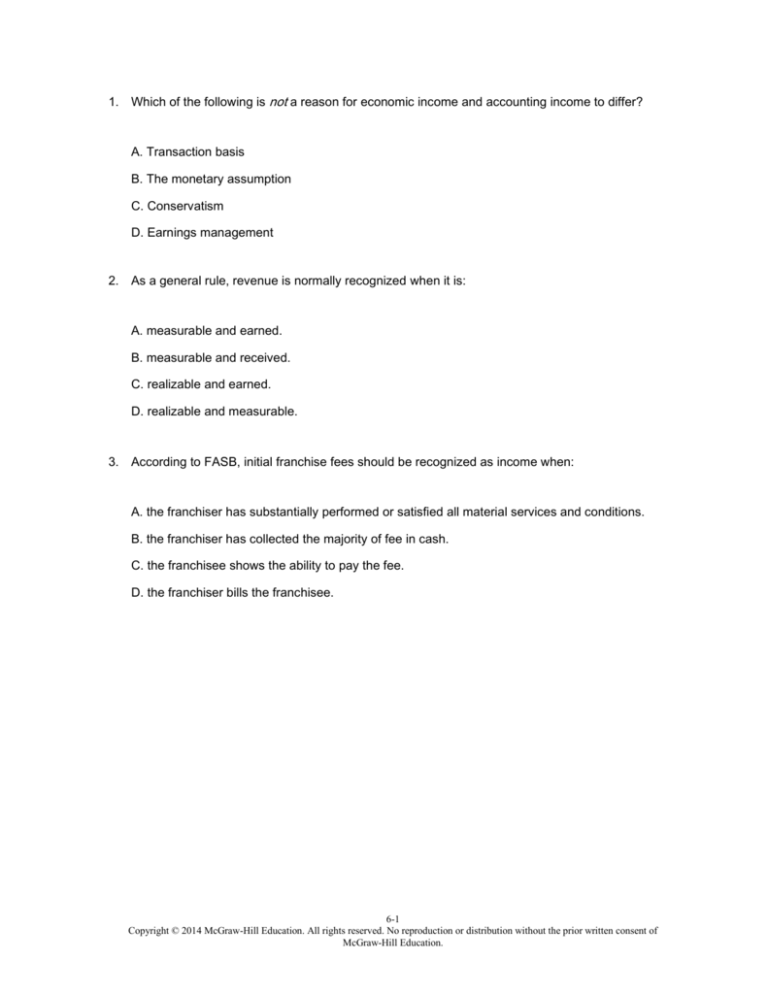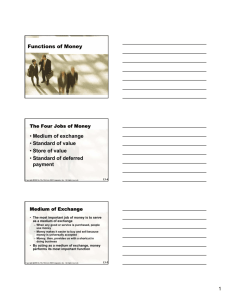
1. Which of the following is not a reason for economic income and accounting income to differ?
A. Transaction basis
B. The monetary assumption
C. Conservatism
D. Earnings management
2. As a general rule, revenue is normally recognized when it is:
A. measurable and earned.
B. measurable and received.
C. realizable and earned.
D. realizable and measurable.
3. According to FASB, initial franchise fees should be recognized as income when:
A. the franchiser has substantially performed or satisfied all material services and conditions.
B. the franchiser has collected the majority of fee in cash.
C. the franchisee shows the ability to pay the fee.
D. the franchiser bills the franchisee.
6-1
Copyright © 2014 McGraw-Hill Education. All rights reserved. No reproduction or distribution without the prior written consent of
McGraw-Hill Education.
4. Which of the following combinations of accounting practices will lead to the highest reported
earnings in an inflationary environment?
A. Option A
B. Option B
C. Option C
D. Option D
5. Which of the following is correct?
I. If a company uses straight-line depreciation for financial reporting purposes, it is very likely they
have a deferred tax liability with respect to its depreciable assets.
II. Straight-line depreciation yields an increasing rate of return on book value over the life of an
asset.
III. Straight-line depreciation results in lower tax payments than accelerated depreciation methods
over the life of an asset.
IV. If a company revises its estimate of the useful life of an asset upwards this will decrease
annual depreciation expense.
A. I, II, III, and IV
B. I, II, and IV
C. I, II, and III
D. I and IV
6-2
Copyright © 2014 McGraw-Hill Education. All rights reserved. No reproduction or distribution without the prior written consent of
McGraw-Hill Education.
6. Which of the following statements concerning deferred taxes is correct?
A. Deferred taxes will not be found in the asset section of a balance sheet.
B. Deferred taxes arise from permanent differences in GAAP and tax accounting.
C. Deferred taxes will only decrease when a cash payment is made.
D. Deferred taxes arising from the depreciation of a specific asset will ultimately reduce to zero as
the item is depreciated.
7. Differences in taxable income and pretax accounting income that will not be offset by
corresponding differences or "turn around" in future periods are called:
A. timing differences.
B. circular differences.
C. permanent differences.
D. reverse differences.
8. Compared with companies that expense costs, firms that capitalize costs can be expected to
report:
A. higher asset levels and lower equity levels.
B. higher asset levels and higher equity levels.
C. lower asset levels and higher equity levels.
D. lower asset levels and lower equity levels.
6-3
Copyright © 2014 McGraw-Hill Education. All rights reserved. No reproduction or distribution without the prior written consent of
McGraw-Hill Education.
9. Two growing firms are identical except that one firm capitalizes, whereas the other firm expenses
costs for long-lived resources over time. For these two firms, which of the following statements is
generally true?
I. The expensing firm will show a more volatile pattern of reported income than capitalizing firm.
II. The expensing firm will show a less volatile pattern of return on assets than the capitalizing firm.
III. The expensing firm will show lower cash flows from operations than the capitalizing firm.
A. I only
B. II only
C. I and III only
D. II and III only
10. Which of the following statements is correct?
I. Tax loss carrybacks result in deferred tax assets.
II. Tax loss carryforwards result in deferred tax assets.
III. The tax valuation account is used to adjust deferred tax liabilities if it is "more likely than not"
that they will not result in increased future taxes.
A. I only
B. II only
C. III only
D. I and II
6-4
Copyright © 2014 McGraw-Hill Education. All rights reserved. No reproduction or distribution without the prior written consent of
McGraw-Hill Education.
11. If a company changes the useful life of its assets from 10 years to 12 years, this will be recorded
as:
A. a nonrecurring gain.
B. an extraordinary item.
C. a change in accounting principle.
D. None of the above
12. Which of the following is true with respect to extraordinary items?
I. Extraordinary items are recorded net of tax in income statement.
II. Extraordinary items, by definition, are probable and unusual in nature.
III. By definition, gains and losses from strikes are always extraordinary.
IV. By definition, gains and losses from sale of property, plant and equipment are never
extraordinary.
A. I and IV
B. I, III, and IV
C. II and IV
D. I, II, and III
6-5
Copyright © 2014 McGraw-Hill Education. All rights reserved. No reproduction or distribution without the prior written consent of
McGraw-Hill Education.
13. Which of the following would be considered an extraordinary item?
I. Write-down of receivables
II. Gains on disposal of a business segment
III. Loss of inventory resulting from a fire
IV. Loss resulting from a strike
A. I and IV
B. I, III, and IV
C. III only
D. I, II, and III
14. Based on GAAP, which of the following is true of comprehensive income?
A. It should be reported as part of sales in the income statement.
B. It can be reported as part of statement of shareholders' equity.
C. It should be reported as a line item before earnings after tax in the balance sheet.
D. It should be reported as part of operating activities in the statement of cash flows.
15. The intrinsic value approach ignores two types of costs:
A. interest cost and opportunity cost.
B. opportunity cost and exercise cost.
C. interest cost and option cost.
D. carrying cost and interest cost.
6-6
Copyright © 2014 McGraw-Hill Education. All rights reserved. No reproduction or distribution without the prior written consent of
McGraw-Hill Education.
True / False Questions
16. Economic income and accounting income are always the same.
True
False
17. The matching principle in accounting prescribes that costs must be recognized in the same period
when the related revenues are recognized.
True
False
18. Revenue from sales where the buyer has the right of return can only be recognized after the return
period has expired.
True
False
19. If two firms are identical except that one firm uses percentage-of-completion accounting and the
other uses completed contract accounting for revenue recognition, the cash flows of the firms will
be identical.
True
False
20. Generally revenue should be recorded when it is probable and reasonably estimable.
True
False
21. Revenues are earned inflows that arise from a company's ongoing business activities.
True
False
22. Gains are earned inflows that arise from a company's ongoing business activities.
True
False
23. Comprehensive income is computed by adjusting net income, on an after-tax basis, for certain
unrealized gains and losses.
True
False
6-7
Copyright © 2014 McGraw-Hill Education. All rights reserved. No reproduction or distribution without the prior written consent of
McGraw-Hill Education.
24. For item to be considered extraordinary, it should be either unusual in nature or infrequent in
occurrence.
True
False
25. For item to be considered a special item, it should be either unusual in nature or infrequent in
occurrence but not both.
True
False
26. Accounting changes are usually cosmetic and do not yield cash flow consequences.
True
False
27. A long-term asset is said to be impaired when its fair value is below its book value.
True
False
28. Income from continuing operations is a measure that excludes certain nonrecurring items, such as
extraordinary items, and the effects of discontinued operations, from net income.
True
False
29. Smythe Corporation is in the real estate development business. If they sell a piece of land for
$50,000 that they had previously purchased for $45,000, they should record a loss of $5,000.
True
False
30. For companies in an expansion phase, capitalizing interest may result in higher earnings over an
extended period of time, compared to expensing interest.
True
False
31. The capitalization of interest costs during construction increases future net income.
True
False
32. Software costs may be capitalized once a company can show that the product is technologically
feasible.
True
False
6-8
Copyright © 2014 McGraw-Hill Education. All rights reserved. No reproduction or distribution without the prior written consent of
McGraw-Hill Education.
33. A company that capitalizes costs, rather than expensing them will have a higher asset turnover.
True
False
34. Extraordinary items are defined as those that are both unusual in nature and infrequent in
occurrence. These items are disclosed, net of tax in the income statement.
True
False
35. Accounting errors are considered accounting changes and treated accordingly.
True
False
36. When a company disposes of a segment of its business, it must restate all prior year financial
statements as if it had never owned that segment of the business.
True
False
37. Deferred taxes arise due to temporary timing differences in recognizing items for tax and financial
reporting purposes.
True
False
38. If a company depreciates an asset at a faster rate for tax purposes than for financial reporting
purposes this will give rise to a deferred tax liability.
True
False
39. A deferred tax liability imposes an obligation on the business to pay taxes.
True
False
40. Some items appear on a company's income statement but never appear on its tax return.
True
False
6-9
Copyright © 2014 McGraw-Hill Education. All rights reserved. No reproduction or distribution without the prior written consent of
McGraw-Hill Education.







